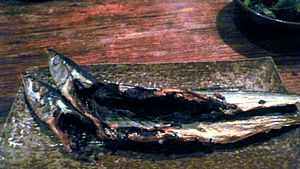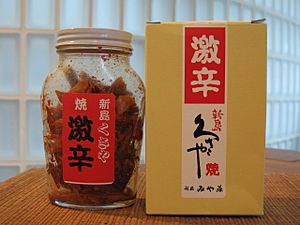Kusaya facts for kids
Kusaya (くさや) is a special kind of fish from the Izu Islands in Japan. It's made by salting, drying, and then fermenting the fish. Fermenting means letting it change over time with good bacteria, which gives it a unique flavor and smell. Kusaya is known for its very strong smell. Some people say it smells a bit like the Swedish fermented herring called surströmming.
What Kusaya Tastes Like
Even though kusaya has a very strong smell, its taste is actually quite mild and pleasant. People often enjoy eating kusaya with traditional Japanese drinks like sake or shōchū. A popular local drink to have with it is called Shima Jiman, which means island pride.
The special liquid used to make kusaya is full of good things like vitamins and natural acids. These include acetic acid, propionic acid, and amino acids. These ingredients add a lot of healthy nutrients to the dried fish.
The Story of Kusaya
Kusaya first came from the Izu Islands, probably on Niijima island. A long time ago, during the Edo period (1603-1868), people on these islands made their living by producing salt. They had to pay high taxes to the government using the salt they made.
Because salt was so valuable and taxes were high, they had to be very careful with it. They used the same salt water, called brine, many times to cure their fish. Over time, this brine became very strong and gave the fish a unique, pungent smell. This is how kusaya was born!
The special, tea-colored, sticky, and smelly brine was so important that families passed it down from one generation to the next. It was like a secret family recipe. Today, kusaya is made on several Izu Islands. However, many people say that the kusaya from Niijima island still has the strongest smell.
How Kusaya is Made
To make kusaya, fish like Mackerel scad (Decapterus macarellus) or flying fish are used. First, the fish are washed very carefully in clean water.
Next, they are soaked in a special brine called kusaya eki (くさや液, lit. kusaya liquid/juice) for about eight to twenty hours. This brine is not as salty as regular fish-curing brines. It has about 8% salt, while other brines have 18% to 20% salt.
After soaking, the fish are taken out and laid under the sun to dry. This drying process usually takes one or two days. If you visit the Niijima-Mura Museum on Niijima island, you can see exhibits and even a video that show exactly how kusaya is made!
See also
 In Spanish: Kusaya para niños
In Spanish: Kusaya para niños



